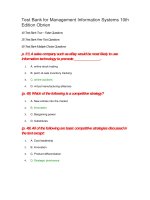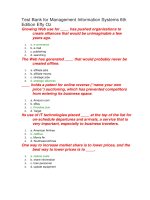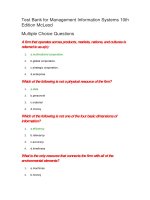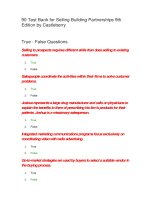Test bank for statistics for management and economics 9th edition by keller
Bạn đang xem bản rút gọn của tài liệu. Xem và tải ngay bản đầy đủ của tài liệu tại đây (52.44 KB, 6 trang )
Full file at />
CHAPTER 2 SECTION 1: GRAPHICAL DESCRIPTIVE TECHNIQUES I
TRUE/FALSE
1. Your age group (1-9; 10-19; 20-29; 30-39; etc.) is an interval variable.
ANS: F
PTS: 1
REF: SECTION 2.1
NAT: Analytic; Descriptive Statistics
2. Your gender is a nominal variable.
ANS: T
PTS: 1
REF: SECTION 2.1
NAT: Analytic; Descriptive Statistics
3. Your final grade in a course (A, B, C, D, E) is a nominal variable.
ANS: F
PTS: 1
REF: SECTION 2.1
NAT: Analytic; Descriptive Statistics
4. Your age is an interval variable.
ANS: T
PTS: 1
REF: SECTION 2.1
NAT: Analytic; Descriptive Statistics
5. Interval data may be treated as ordinal or nominal.
ANS: T
PTS: 1
REF: SECTION 2.1
NAT: Analytic; Descriptive Statistics
6. Whether or not you are over the age of 21 is a nominal variable.
ANS: T
PTS: 1
REF: SECTION 2.1
NAT: Analytic; Descriptive Statistics
7. The values of quantitative data are categories.
ANS: F
PTS: 1
REF: SECTION 2.1
NAT: Analytic; Descriptive Statistics
8. Interval data, such as heights, weights, and incomes, are also referred to as quantitative or numerical
data.
ANS: T
PTS: 1
REF: SECTION 2.1
NAT: Analytic; Descriptive Statistics
9. All calculations are permitted on interval data.
ANS: T
PTS: 1
REF: SECTION 2.1
NAT: Analytic; Descriptive Statistics
10. Nominal data are also called qualitative or categorical data.
ANS: T
PTS: 1
REF: SECTION 2.1
NAT: Analytic; Descriptive Statistics
11. A variable is some characteristic of a population or sample.
ANS: T
PTS: 1
REF: SECTION 2.1
NAT: Analytic; Descriptive Statistics
12. With nominal data, there is one and only one way the possible values can be ordered.
ANS: F
PTS: 1
REF: SECTION 2.1
NAT: Analytic; Descriptive Statistics
13. You cannot calculate and interpret differences between numbers assigned to nominal data.
ANS: T
PTS: 1
REF: SECTION 2.1
NAT: Analytic; Descriptive Statistics
MULTIPLE CHOICE
14. The classification of student major (accounting, economics, management, marketing, other)
is an example of a(n)
a. nominal random variable.
buy this full document at
Full file at />
b. interval random variable.
c. continuous random variable.
d. parameter.
ANS: A
PTS: 1
REF: SECTION 2.1
NAT: Analytic; Descriptive Statistics
15. The classification of student class designation (freshman, sophomore, junior, senior) is an
example of a(n)
a. nominal random variable.
b. interval random variable.
c. ordinal random variable.
d. a parameter.
ANS: C
PTS: 1
REF: SECTION 2.1
NAT: Analytic; Descriptive Statistics
16. A researcher wishes to estimate the textbook costs of first-year students at Barry University.
To do so, he recorded the textbook cost of 300 first-year students and found that their
average textbook cost was $195 per semester. The variable of interest to the researcher is
a. textbook cost.
b. class rank.
c. number of students.
d. name of university.
ANS: A
PTS: 1
REF: SECTION 2.1
NAT: Analytic; Descriptive Statistics
17. All calculations are permitted on what type of data?
a. Interval data
b. Nominal data
c. Ordinal data
d. All of these choices are true.
ANS: A
PTS: 1
REF: SECTION 2.1
NAT: Analytic; Descriptive Statistics
18. Values must represent ordered rankings for what type of data?
a. Interval data
b. Nominal data
c. Ordinal data
d. None of these choices.
ANS: C
PTS: 1
REF: SECTION 2.1
NAT: Analytic; Descriptive Statistics
19. For what type of data are frequencies the only calculations that can be done?
a. Interval data
b. Nominal data
c. Ordinal data
d. None of these choices.
ANS: B
PTS: 1
REF: SECTION 2.1
NAT: Analytic; Descriptive Statistics
20. For which type of data are the values arbitrary numbers?
a. Interval data
b. Nominal data
c. Ordinal data
d. None of these choices.
buy this full document at
Full file at />
ANS: B
PTS: 1
NAT: Analytic; Descriptive Statistics
REF: SECTION 2.1
COMPLETION
21. The Chief of Police conducted a survey of the officers on his squad. An officer’s shooting score at
target practice is an example of a(n) ____________________ variable.
ANS:
interval
quantitative
numerical
PTS: 1
REF: SECTION 2.1
NAT: Analytic; Descriptive Statistics
22. The Dean of Students conducted a survey on campus. The gender of each student is an example of a(n)
____________________ variable.
ANS:
nominal
categorical
qualitative
PTS: 1
REF: SECTION 2.1
NAT: Analytic; Descriptive Statistics
23. The Dean of Students conducted a survey on campus. Class rank (Freshman, Sophomore, Junior, and
Senior) is an example of a(n) ____________________ variable.
ANS: ordinal
PTS: 1
REF: SECTION 2.1
NAT: Analytic; Descriptive Statistics
24. The final grade received in a Literature course (A, B, C, D, or F) is an example of a(n)
____________________ variable.
ANS:
nominal
categorical
qualitative
PTS: 1
REF: SECTION 2.1
NAT: Analytic; Descriptive Statistics
25. In purchasing a used computer, there are a number of variables to consider. The age of the computer is
an example of a(n) ____________________ variable.
ANS:
interval
quantitative
numerical
PTS: 1
REF: SECTION 2.1
NAT: Analytic; Descriptive Statistics
26. In purchasing an automobile, there are a number of variables to consider. The body style of the car
(sedan, coupe, wagon, etc.) is an example of a(n) ____________________ variable.
ANS:
nominal
categorical
qualitative
PTS: 1
REF: SECTION 2.1
NAT: Analytic; Descriptive Statistics
buy this full document at
Full file at />
SHORT ANSWER
27. At the end of a safari, the tour guide asks the vacationers to respond to the questions listed below. For
each question, determine whether the possible responses are interval, nominal, or ordinal.
a.
b.
c.
How many safaris have you taken prior to this one?
Do you feel that your tour safari lasted sufficiently long (yes/no)?
Which of the following features of the accommodations did you find most attractive:
location, facilities, room size, service, or price?
d. What is the maximum number of hours per day that you would like to spend traveling?
e. Is your overall rating of this safari: excellent, good, fair, or poor?
ANS:
a. Interval
b. Nominal
c. Nominal
d. Interval
e. Ordinal
PTS: 1
REF: SECTION 2.1
NAT: Analytic; Descriptive Statistics
28. Before leaving a particular restaurant, customers are asked to respond to the questions listed below.
For each question, determine whether the possible responses are interval, nominal, or ordinal.
a.
b.
c.
d.
What is the approximate distance (in miles) between this restaurant and your residence?
Have you ever eaten at this restaurant before?
On how many occasions have you eaten at the restaurant before?
Which of the following attributes of this restaurant do you find most attractive: service,
prices, quality of the food, or the menu?
e. What is your overall rating of the restaurant: excellent, good, fair, or poor?
ANS:
a. Interval
b. Nominal
c. Interval
d. Nominal
e. Ordinal
PTS: 1
REF: SECTION 2.1
NAT: Analytic; Descriptive Statistics
29. For each of the following examples, identify the data type as nominal, ordinal, or interval.
a.
b.
c.
d.
The final grade received by a student in a neuro-science class.
The number of students in a Physics course.
The starting salary of a PhD graduate.
The size of an order of fries (small, medium, large, super-size) purchased by a Burger
King customer.
e. The college you are enrolled in (Arts and Sciences, Business, Education, etc.).
ANS:
a.
b.
c.
d.
Ordinal
Interval
Interval
Ordinal
buy this full document at
Full file at />
e. Nominal
PTS: 1
REF: SECTION 2.1
NAT: Analytic; Descriptive Statistics
30. For each of the following, indicate whether the variable of interest is nominal or interval.
a. Your marital status.
b. Whether you are a U.S. citizen.
c. Sally's travel time from her dorm to the student union on campus.
d. The amount of time you spent last week on your homework.
e. The number of cars parked in a certain parking lot at any given time.
f. Kate’s favorite brand of sneakers.
ANS:
a. Nominal
b. Nominal
c. Interval
d. Interval
e. Interval
f. Nominal
PTS: 1
REF: SECTION 2.1
NAT: Analytic; Descriptive Statistics
31. Provide one example of ordinal data; one example of nominal data; and one example of interval data.
ANS:
Ordinal data example: Response to a market research survey question measured on the Likert scale
using the code: 1 = strongly agree, 2 = agree, 3 = neutral, 4 = disagree, and 5 = strongly disagree.
Nominal data example: Voters’ political party affiliation for using the code: 1 = Democrat, 2 =
Republican, and 3 = Independent.
Interval data example: The temperature on a golf course during the U.S. Master’s Tournament.
(degrees Fahrenheit).
PTS: 1
REF: SECTION 2.1
NAT: Analytic; Descriptive Statistics
32. Explain why religious preference is not an ordinal variable.
ANS:
The values of religious preference cannot be ranked in order in any way.
PTS: 1
REF: SECTION 2.1
NAT: Analytic; Descriptive Statistics
33. Explain the difference between ordinal data and interval data.
ANS:
The critical difference between them is that the intervals or differences between values of interval data
are consistent and meaningful. That is, we can calculate the difference and interpret the results.
Because the codes representing ordinal data are arbitrarily assigned except for the order, we cannot
calculate and interpret differences.
PTS: 1
REF: SECTION 2.1
NAT: Analytic; Descriptive Statistics
34. Give an example of interval data that can also be treated as ordinal data and nominal data.
ANS:
Example: Your actual age is interval data; your age group (1-17; 18-24; 25-30; etc) is ordinal data; and
whether or not you are over age 25 is nominal data.
buy this full document at
Full file at />
PTS: 1
REF: SECTION 2.1
NAT: Analytic; Descriptive Statistics
buy this full document at









